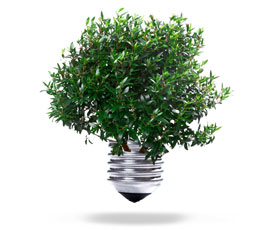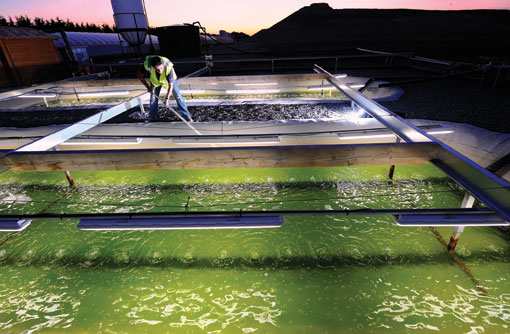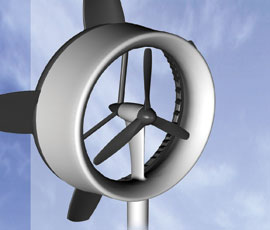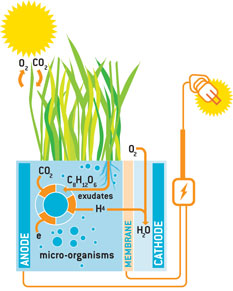Green ideas shaping the future of renewable energy

Renewables technology is developing at a rapid pace, with a number of exciting new projects moving from concept to commercial reality. Paul Spackman reports
What is it?
This is perhaps the biggest and most talked-about of the next generation of advanced biofuels technology. It works by exploiting the natural ability of algae to fix carbon dioxide using just sunlight and seawater, to produce oil. This oil can then be refined into ethanol for use in transport fuels – so-called “green crude” (shown below).
How does it work?
Specific strains of algae are cultivated in either shallow lagoons or in closed photobioreactors (PBRs) to produce biofuels via a number of methods. Many systems are similar to conventional farming, whereby algae are grown, harvested – for example, using centrifuges, microscreens or froth flotation – and bioprocessed to recover oils from within the cells.
These oils can then be refined (by hydrocracking and hydrogenation, for instance) and processed into petrol or aviation fuel.
The controlled, contained environment of a PBR offers higher productivity than an open lagoon, as light levels, nutrients, carbon dioxide, air and temperature can all be controlled, but capital cost is higher.
Some more advanced systems have modified algae to continuously excrete oils through their cell walls, so that oil can be extracted and processed without killing the cells.
Algae can also be grown without light by using sugar or cellulosic biomass for energy and carbon.
Why is it the next big thing?
Many of the big chemical firms are developing algal biofuels and they argue that such biofuels address the biggest issue with first generation biofuels (such as bioethanol from wheat), namely sustainability.
The European Biofuels Technology Platform says algae have the potential to produce considerably more biomass and oils per hectare than terrestrial biomass (typically five to 10 times more), and can be cultivated on marginal land, so do not compete with food or other crops.
Algae can grow 20-30 times faster than conventional food crops, therefore allowing several harvests in a short period, experts say. Also, algae use seawater, which is in plentiful supply and can therefore be grown on more saline land or in more drought-prone areas.

How close is it to becoming a commercial reality in the UK?
While a number of international companies are developing algae-based biofuels, their commercialisation varies. In 2010, the Carbon Trust created a “dream team” of 11 universities and research institutions across the UK tasked to work together to meet a target of producing 70m litres of algae biofuel a year by 2030.
The Carbon Trust has invested £8m into the project over three years, using funding from the Department for Transport and the Department for Energy and Climate Change.
What is it?
A device that converts ambient energy from two different sources, such as light, heat, vibration or radio waves, into electricity.
How does it work?
Light and heat are the main forms of energy that can be captured simultaneously, and Japanese firm Fujitsu Laboratories has developed an organic material that can do just this. By changing the electrical circuits connecting two types of semiconductor materials – P-type and N-type – the device can function as a photovoltaic cell or thermoelectric generator.
The firm says the photovoltaic cell is efficient enough to even generate electricity from indoor lighting and the organic material used keeps technology costs low.
Why is it the next big thing?
Fujitsu says the technology doubles the “energy capture potential” of a single device, as existing technologies such as solar panels only generate electricity from one source or another, not both. The device is also able to augment one energy source with the other where one is lacking.
It is likely to be of most use where batteries or wiring would be impractical. Initial prototypes are wristband-sized and could be used in medical situations for devices to measure body temperature, blood pressure or heartbeat, the firm says.
However, it also has potential to be used to power environmental sensing or weather forecasting equipment in remote areas where it would be difficult to run an electric supply or change batteries.
How close is it to becoming a commercial reality in the UK?
The technology is still under development, so it may be some time before it becomes commercial reality and longer before there are agricultural applications in the UK. However, Fujitsu says it is continuing development work to increase the performance of hybrid devices, with aims to commercialise the technology by around 2015.
What is it?
The Controlled Airflow Technology Turbine (CATT) is a new type of wind turbine that can be used in sites with turbulent and variable air flow that makes them unsuitable for conventional wind turbines.
How does it work?
The CATT is similar in principle to a conventional three-blade turbine, but with one key difference. In front of the turbine blades is a circular aerofoil duct, together with a circular rotor.
The aerofoil deflects the turbulent wind into the rotor, which in turn acts as a suction pump and feeds air through to the turbine blades in a more consistent flow.

Why is it the next big thing?
Chris Gaskell from Freegen Research, which invented the system, says it allows wind turbines to be installed in previously unsuitable sites, such as close to buildings, trees, or in valleys.
“Generally for conventional turbines you can’t have any more than 15% wind turbulence before power output starts to decrease considerably and 50% turbulence can lead to a 70% reduction in output.
“But CATT technology allows wind turbines to be located on sites that have a combination of moderate wind speeds [5-6m/sec] and high wind turbulence [50% +].” In such cases, he says the system can reduce turbulence to 10% and increase velocity by up to 50%.
Predicted annual output from a 20kW CATT at an average 5m/sec wind speed site with 60% turbulence is 22,000kWh, rising to around 60,000kWh at a wind speed of 7m/sec.
How close is it to becoming a commercial reality in the UK?
A 20kW prototype CATT installation is already in operation in the Midlands and Freegen is looking for an investor or a corporate partner to contribute up to £2m towards a business supplying CATTs to commercial/industrial buildings/infrastructure/landowner market sectors.
Currently the CATT system only comes in one size, 20kW, which is 25m high and costs around £60,000 installed. Farmers or landowners wanting more generating capacity than this would need to install multiple turbines, says Mr Gaskell.
Theoretically the aerofoil system could be retrofitted to other turbines, but in practice it would be too difficult to do and is not an option being explored, he notes.
What is it?
A way of generating electricity from the natural interaction between living plant roots and soil bacteria, pioneered by researchers at Wageningen University in the Netherlands.
How does it work?
The fuel cell uses electrodes to absorb the electrons produced when bacteria around plant roots break down organic residues (rhizodeposits). Various plant species can be used, including grasses such as common cordgrass and, in warmer countries, rice.
Plants are placed with their roots in the “bioanode” of the fuel cell (see picture, right), which contains electrochemically active micro-organisms.
Micro-organisms donate electrons to the anode and due to the potential difference created, electrons then flow from the anode through an electrical circuit with a load or resistor, to a cathode.
As well as producing low-voltage direct current, the process also produces hydrogen, which could potentially be used in biofuels, researchers say.

Why is it the next big thing?
Researchers claim that by its nature, the plant-microbial fuel cell has potential to be five-times more efficient than conventional bioenergy systems and will be able to produce electricity 24 hours a day from living plants.
They say that in remote areas, the current capacity of plant-microbial fuel cells already makes them an economic rival to solar panels. What’s more, systems have minimal visual impact, do not interfere with natural ecosystems and do not compete with agricultural land.
How close is it to becoming a commercial reality in the UK?
The plant-microbial fuel cell concept was patented five years ago by the environmental technology group at Wageningen University.
The concept has evolved into a wider EU PlantPower project and since 2009 a consortium of European universities, research institutes and companies has been developing plant microbial fuel cell technology.
Spin-off company Plant-e was set up in 2009 to develop products using the technology and it hopes to launch its first products next year.
The technology has been tested on a small scale, capable of generating 0.4W/sq m of plant growth, and researchers say this is more than could be generated by fermenting biomass from the equivalent area (as in biogas production).
The technology could produce up to 3.2W/sq m in the future, they say. A demonstration “green electricity roof” is in operation at the Netherlands Institute of Ecology, based in Wageningen.
Systems will initially be aimed at units to go on flat roofs, but they hope the technique could soon be applied in larger marshland areas.
It is estimated that at an output of 3.2W/sq m, a fuel cell system on a roof measuring 100sq m would generate enough electricity to supply a household with an average consumption of 2,800kWh/year.
Researchers hope that green energy-producing roofs will become a reality within a few years and production on a larger scale will follow soon after 2015.
However, they acknowledge there are still technological issues to resolve, as techniques for making the system renewable and sustainable need improvement and they also need to find a way of limiting the amount of material used by the electrodes.
FIND OUT MORE
Algal biofuels
www.biofuelstp.eu/algae.html
www.makebiofuel.co.uk
www.epsrc.ac.uk
Hybrid energy harvesting
www.fujitsu.com
CATT
freegenresearch@tiscali.co.uk, 0121 455 6037
Plant-microbial fuel cell
www.plantpower.eu
www.ete.wur.nl
www.plant-e.com
www.nioo.knaw.nl/en/building
Keep up to date with the latest renewable energy news
